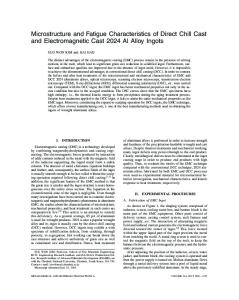Instrumented indentation probing of laser surface-refined cast Al alloy
- PDF / 324,676 Bytes
- 6 Pages / 612 x 792 pts (letter) Page_size
- 70 Downloads / 351 Views
Laura Riester High Temperature Materials Laboratory, Oak Ridge National Laboratory, Oak Ridge, Tennessee 37831
Narendra B. Dahotre Department of Materials Science and Engineering, Center for Laser Applications, University of Tennessee, Knoxville, Tennessee 37996; and Oak Ridge National Laboratory, Oak Ridge, Tennessee 37831 (Received 13 June 2003; accepted 25 September 2003)
The surface layer of A319 alloy was refined by selective remelting using laser energy. Instrumented indentation technique was used to measure hardness (H) and elastic modulus (E) of the laser-melted layer. Berkovich tip was used to indent the material for 100-nm, 200-nm, 500-nm, and 1000-nm depths. The H and the E were found to be 1.22 GPa and 78.2 GPa, respectively, for 1000-nm indentation depths. The variances associated with H and E were minimal, whereas, the same for substrate possessed significant scattering. Also, H and E increased with decreasing depth of indentation. Closer examination suggested that when the heterogeneity in the material was in the scale of indentation depth, significant scattering took place and the hard phase Si influenced the average hardness. However, the influence of indentation depth on elastic modulus was not statistically significant.
I. INTRODUCTION
Use of lightweight materials has become more prevalent as technological, economic, environmental, and logistics needs provide motivation to reduce weight to improve performance. In many applications, lightweight and low-cost aluminum–silicon-based alloys (density ≈ 2.68 g/cm3) have replaced other high-density materials, including ferrous alloys (density ≈ 7.8 g/cm3). Several Al-based alloys and metal-matrix composites, such as A319, A356, A390, and A360, are in use.1 One such alloy, A319, has a microstructure consisting of primary Al and divorce-eutectic phase mixture of Al + Si, AlxCuy, and Al–Si–Cu. However, unsatisfactory surface-related properties prevented its direct usage in many other applications. Fortunately, Al–Si binary system possesses a modifiable microstructure. The size, shape, and distribution of the Si phase are amenable to extensive modification by several techniques that would allow depression of the aluminum–silicon eutectic growth temperature.2 Additions of Sr amounting to less than 100 ppm in the melt prior to casting is known to refine greatly distribution and morphology of Si particles3 but has little effect on aluminum dendrites and other intermetallic phases. 202
http://journals.cambridge.org
J. Mater. Res., Vol. 19, No. 1, Jan 2004 Downloaded: 19 Mar 2015
Rapid solidification is another technique in which the eutectic growth temperature can be depressed, thereby refining the microstructure of Al–Si alloy.4,5 Rapid solidification refines both dendrites and eutectic phases. By controlling solidification parameters such as pouring temperature, cooling rate, modifier addition, and so forth, one can attain a tailored microstructure of these alloys. Consequently, widely different sets of properties can be attained depending on structure
Data Loading...










